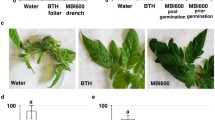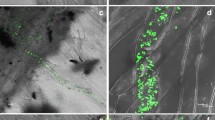Abstract
Plants are defended from attack by emission of volatile organic compounds (VOCs) that can act directly against pathogens and herbivores or indirectly by recruiting natural enemies of herbivores. However, microbial VOC have been less investigated as potential triggers of plant systemic defense responses against pathogens in the field. Bacillus amyloliquefaciens strain IN937a, a plant growth-promoting rhizobacterium that colonizes plant tissues, stimulates induced systemic resistance (ISR) via its emission of VOCs. We investigated the ISR capacity of VOCs and derivatives collected from strain IN937a against bacterial spot disease caused by Xanthomonas axonopodis pv. vesicatoria in pepper. Of 15 bacterial VOCs and their derivatives, 3-pentanol, which is a C8 amyl alcohol reported to be a component of sex pheromones in insects, was selected for further investigation. Pathogens were infiltrated into pepper leaves 10, 20, 30, and 40 days after treatment and transplantation to the field. Disease severity was assessed 7 days after transplantation. Treatment with 3-pentanol significantly reduced disease severity caused by X. axonopodis and naturally occurring Cucumber mosaic virus in field trials over 2 years. We used quantitative real-time polymerase chain analysis to examine Pathogenesis-Related genes associated with salicylic acid (SA), jasmonic acid (JA), and ethylene defense signaling. The expression of Capsicum annuum Pathogenesis-Related protein 1 (CaPR1), CaPR2, and Ca protease inhibitor2 (CaPIN2) increased in field-grown pepper plants treated with 3-pentanol. Taken together, our results show that 3-pentanol triggers induced resistance by priming SA and JA signaling in pepper under field conditions.



Similar content being viewed by others
Abbreviations
- PGPR:
-
Plant growth-promoting rhizobacteria
- ISR:
-
Induced systemic resistance
- VOC:
-
Volatile organic compound
References
Alstrom S (1991) Induction of disease resistance in common bean susceptible to halo blight bacterial pathogen after seed bacterization with rhizosphere pseudomonads. J Gen Appl Microbiol 37:495–501
Arrebola E, Sivakumar D, Korsten L (2010) Effect of volatile compounds produced by Bacillus strains on postharvest decay in citrus. Biol Control 53:122–128
Bukovinszky T, Gols R, Posthumus M, Vet L, Van Lenteren J (2005) Variation in plant volatiles and attraction of the parasitoid Diadegma semiclausum (Heillen). J Chem Ecol 31:461–480
Creelman RA, Mullet JE (1997) Biosynthesis and action of jasmonates in plants. Annu Rev Plant Physiol Plant Mol Biol 48:355–381
Crespo JG, Manrique G (2007) Mating behavior of the hematophagous bug Triatoma infestans: role of Brindley’s and metasternal glands. J Insect Physiol 53:708–714
Conrath U, Beckers GJ, Flors V, García-Agustín P, Jakab G, Mauch F, Newman MA, Pieterse CM, Poinssot B, Pozo MJ (2006) Priming: getting ready for battle. Mol Plant Microbe Interact 19:1062–1071
Davis TS, Crippen TL, Hofstetter RW, Tomberlin JK (2013) Microbial volatile emissions as insect semiochemicals. J Chem Ecol 39:840–59
De Meyer G, Audenaert K, Höfte M (1999) Pseudomonas aeruginosa 7NSK2-induced systemic resistance in tobacco depends on in planta salicylic acid accumulation but is not associated with PR1a expression. Eur J Plant Pathol 105:513–517
Duijff BJ, Gianinazzi-Pearson V, Lemanceau P (1997) Involvement of the outer membrane lipopolysaccharides in the endophytic colonization of tomato roots by biocontrol Pseudomonas fluorescens strain WCS417r. New Phytol 135:325–334
Farag MA, Ryu CM, Sumner LW, Pare PW (2006) GC-MS SPME profiling of rhizobacterial volatiles reveals prospective inducers of growth promotion and induced systemic resistance in plants. Phytochemistry 67:2262–2268
Farag MA, Zhang H, Ryu CM (2013) Dynamic chemical communication between plants and bacteria through airborne signals: Induced resistance by bacterial volatiles. J Chem Ecol 39:1007–1018
Fernando WGD, Ramarathnam R, Krishnamoorthy AS, Savchuk SC (2005) Identification and use of potential bacterial organic antifungal volatiles in biocontrol. Soil Biol Biochem 37:955–964
Funes H, Zerba E, Audino PG (2009) Comparison of three types of traps baited with sexual pheromones for ambrosia beetle megaplatypus mutatus (coleoptera: Platypodinae) in poplar plantations. J Econ Entomol 102:1546–1550
Funes H, Griffo R, Zerba E, Gonzalez-Audino P (2011) Mating disruption of the ambrosia beetle Megaplatypus mutatus in poplar and hazelnut plantations using reservoir systems for pheromones. Entomol Exp Appl 139:226–234
Gatti Liguori P, Zerba E, Alzogaray RA, Gonzalez Audino P (2008) 3-pentanol: a new attractant present in volatile emissions from the ambrosia beetle, megaplatypus mutatus. J Chem Ecol 34:1446–1451
Gols R, Bullock JM, Dicke M, Bukovinszky T, Harvey JA (2011) Smelling the wood from the trees: non-linear parasitoid responses to volatile attractants produced by wild and cultivated cabbage. J Chem Ecol 37:795–807
Han SH, Lee SJ, Moon JH, Park KH, Yang KY, Cho BH, Kim KY, Kim YW, Lee MC, Anderson AJ, Kim YC (2006) GacS-dependent production of 2R, 3R-butanediol by Pseudomonas chlororaphis O6 is a major determinant for eliciting systemic resistance against Erwinia carotovora but not against Pseudomonas syringae pv. tabaci in tobacco. Mol Plant Microbe Interact 19:924–930
Hatanaka A (1993) The biogeneration of green odour by green leaves. Phytochemistry 34:1201–1218
Heil M, Silva Bueno JC (2007) Within-plant signaling by volatiles leads to induction and priming of an indirect plant defense in nature. Proc Natl Acad Sci U S A 104:5467–5472
Heil M, Hilpert A, Kaiser W, Linsenmair KE (2000) Reduced growth and seed set following chemical induction of pathogen defence: Does systemic acquired resistance (SAR) incur allocation costs? J Ecol 88:645–654
Iavicoli A, Boutet E, Buchala A, Métraux JP (2003) Induced systemic resistance in Arabidopsis thaliana in response to root inoculation with Pseudomonas fluorescens CHA0. Mol Plant Microbe Interact 16:851–858
Insam H, Seewald MSA (2010) Volatile organic compounds (VOCs) in soils. Biol Fertil Soils 46:199–213
Jetiyanon K, Kloepper JW (2002) Mixtures of plant growth-promoting rhizobacteria for induction of systemic resistance against multiple plant diseases. Biol Control 24:285–291
Jetiyanon K, Fowler WD, Kloepper JW (2003) Broad-spectrum protection against several pathogens by PGPR Mixtures under field conditions in thailand. Plant Dis 87:1390–1394
Kai M, Haustein M, Molina F, Petri A, Scholz B, Piechulla B (2009) Bacterial volatiles and their action potential. Appl Microbiol Biotechnol 81:1001–1012
Kang SH, Cho HS, Cheong H, Ryu CM, Kim JF, Park SH (2007) Two bacterial entophytes eliciting both plant growth promotion and plant defence on pepper (Capsicum annuum L.). J Microbiol Biotechnol 17:96–103
Kessler A, Baldwin I (2001) Defensive function of herbivoreinduced plant volatile emissions in nature. Science 291:2141–2144
Kloepper JW, Ryu CM, Zhang S (2004) Induced systemic resistance and promotion of plant growth by bacillus spp. Phytopathology 94:1259–1266
Kost C, Heil M (2006) Herbivore-induced plant volatiles induce an indirect defense in neighbouring plants. J Ecol 94:619–628
Lee BY, Farag MA, Park HB, Kloepper JW, Lee SH, Ryu CM (2012) Induced resistance by a long-chain bacterial volatile: elicitation of plant systemic defense by a C13 volatile produced by paenibacillus polymyxa. PLoS One 7:e48744
Leeman M, Van Pelt JA, Den Ouden FM, Heinsbroek M, Bakker PA, Schippers B (1995) Induction of systemic resistance against fusarium wilt of radish by lipopolysaccharides of Pseudomonas fluorescens. Phytopathology 85:1021–1027
Li Y, Zhang Z, Jia Y, Shen Y, He H, Fang R, Chen X, Hao X (2008) 3-Acetonyl-3-hydroxyoxindole: a new inducer of systemic acquired resistance in plants. Plant Biotechnol J 6:301–308
Lyon G (2007) Agents that can elicit induced resistance. In: Walters D, Newton A, Lyon G (eds) Induced resistance for plant defence: a sustainable approach to crop protection. Blackwell Publishing, Oxford
Manrique G, Vitta ACR, Ferreira RA, Zani CL, Unelius CR, Lazzari CR, Diotaiuti L, Lorenzo MG (2006) Chemical communication in chagas disease vectors. Source, identity, and potential function of volatiles released by the metasternal and Brindley’s glands of Triatoma infestans adults. J Chem Ecol 32:2035–2052
Mercier J, Manker DC (2005) Biocontrol of soil-borne diseases and plant growth enhancement in greenhouse soilless mix by the volatile-producing fungus Muscodor albus. Crop Prot 24:355–362
Oh S-K, Lee S, Chung E, Park JM, Yu SH, Ryu C-M, Choi D (2006) Insight into Types I and II non-host resistance using expression patterns of defense-related genes in tobacco. Planta 223:1102–1107
Ongena M, Jourdan E, Schäfer M, Kech C, Budzikiewicz H, Luxen A, Thonart P (2005) Isolation of an N-alkylated benzylamine derivative from Pseudomonas putida BTP1 as elicitor of induced systemic resistance in bean. Mol Plant Microbe Interact 18:562–569
Ongena M, Jourdan E, Adam A, Paquot M, Brans A, Joris B, Arpigny JL, Thonart P (2007) Surfactin and fengycin lipopeptides of Bacillus subtilis as elicitors of induced systemic resistance in plants. Environ Microbiol 9:1084–1090
Peer R, Niemann GJ, Schippers B (1991) Induced resistance and phytoalexin accumulation in biological control of Fusarium wilt of carnation by Pseudomonas sp. strain WCS417r. Phytopathology 81:728–734
Rayko H, Johan A.S, Danny K, Andre K, Ian T. B (2008) Shared signals - ‘alarm calls’ from plants increase apparency to herbivores and their enemies in nature. Ecol Lett 11:24–34
Ryu CM (2013) Promoting plant protection by root-associated bacteria. Plant Pathol J 29:123–124
Ryu CM, Farag MA, Hu CH, Reddy MS, Wei HX, Pare PW, Kloepper JW (2003a) Bacterial volatiles promote growth in Arabidopsis. Proc Natl Acad Sci U S A 100:4927–4932
Ryu CM, Farag MA, Hu CH, Reddy MS, Kloepper JW, Pare PW (2004) Bacterial volatiles induce systemic resistance in Arabidopsis. Plant Physiol 134:1017–1026
Shulaev V, Silverman P, Raskin I (1997) Airborne signaling by methyl salicylate in plant pathogen resistance. Nature 385:718–721
Song GC, Ryu CM (2013) Two volatile organic compounds trigger plant self-defense against a bacterial pathogen and a sucking insect in cucumber under open field conditions. Int J Mol Sci 14:9803–9819
Song GS, Choi HK, Ryu CM (2013a) The folate precursor para-aminobenzoic acid elicits induced resistance against Cucumber mosaic virus and Xanthomonas axonopodis. Ann Bot 111:925–993
Song GS, Ryu SY, Kim YS, Lee JY, Choi JS, Choi HK, Ryu CM (2013b) Elicitation of induced resistance against Pectobacterium carotovorum and Pseudomonas syringae by specific individual compounds derived from native Korean plant species. Molecules 18:12877–12895
Spencer M, Ryu C-M, Yang K-Y, Kim YC, Kloepper JW, Anderson AJ (2003) Induced defence in tobacco by Pseudomonas chlororaphis strain O6 involves at least the ethylene pathway. Physiol Mol Plant Pathol 63:27–34
Stout MJ, Thaler JS, Thomma B (2006) Plant-mediated interactions between pathogenic microorganisms and herbivorous arthropods. Annu Rev Entomol 51:663–689
Tally A, Oostendorp M, Lawton K, Staub T, Bassy B (1999) Commercial development of elicitors of induced resistance to pathogens. In: Agrawal AA, Tuzun S, Bent E (eds) Inducible plant defenses against pathogens and herbivores: biochemistry, ecology, and agriculture. Amer. Phytopathol. Soc. Press, St. Paul, pp 357–369
Thaler JS, Agrawal AA, Halitschke R (2010) Salicylate-mediated interactions between pathogens and herbivores. Ecology 91:1075–1082
Van Loon LC (2007) Plant responses to plant growth-promoting rhizobacteria. Eur J Plant Pathol 119:243–254
Van Loon LC, Bakker PA, Pieterse CM (1998) Systemic resistance induced by rhizosphere bacteria. Annu Rev Phytopathol 36:453–483
Vitta ACR, Bohman B, Unelius CR, Lorenzo MG (2009) Behavioral and electrophysiological responses of Triatoma brasiliensis males to volatiles produced in the metasternal glands of females. J Chem Ecol 35:1212–1221
Wei G, Kloepper JW, Tuzun S (1991) Induction of systemic resistance of cucumber to Colletotrichum orbiculare by select strains of plant growth-promoting rhizobacteria. Phytopathology 81:1508–1512
Yang JW, Yu SH, Ryu CM (2009) Priming of defense-related genes confers root-colonizing bacilli-elicited induced systemic resistance in pepper. Plant Pathol J 25:389–399
Yang JW, Yi HS, Kim H, Lee BY, Lee SH, Ghim SY, Ryu CM (2011) Whitefly infestation of pepper plants elicits defence responses against bacterial pathogens in leaves and roots and changes the below-ground microflora. J Ecol 99:46–56
Yi HS, Yang JW, Ryu CM (2013) ISR meets SAR outside: additive action of the endophyte bacillus pumilus INR7 and the chemical inducer, benzothiadiazole, on induced resistance against bacterial spot in field-grown pepper. Front Plant Sci 4:122. doi:10.3389/fpls.2013.00122
Acknowledgments
We thank Dr. Doil Choi for providing the bacterial X. axonopodis strain. Financial support was obtained from the Industrial Source Technology Development Program of the Ministry of Knowledge Economy (10044909) of Korea, the Next-Generation BioGreen 21 Program (SSAC grant #PJ009524), Rural Development Administration, S. Korea, and the KRIBB initiative program, South Korea.
Author information
Authors and Affiliations
Corresponding author
Rights and permissions
About this article
Cite this article
Choi, H.K., Song, G.C., Yi, HS. et al. Field Evaluation of the Bacterial Volatile Derivative 3-Pentanol in Priming for Induced Resistance in Pepper. J Chem Ecol 40, 882–892 (2014). https://doi.org/10.1007/s10886-014-0488-z
Received:
Revised:
Accepted:
Published:
Issue Date:
DOI: https://doi.org/10.1007/s10886-014-0488-z




